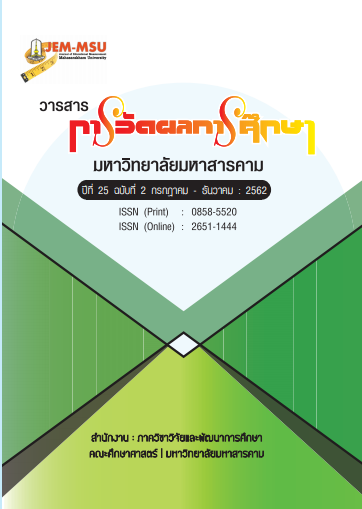The Effective of Brain Mind and Learning Program to Enhance Attention in Primary School Students
Main Article Content
Abstract
This research aimed to 1) study the effects of the Brain, Mind and Learning Program to enhance attention in upper primary school students, and 2) examine the learning achievement of the students who received the Brain, Mind and Learning Program. The sample consisted of 64 grade 5 students. The students were randomized by using cluster random sampling and divided into two groups; 32 students were for the experimental group, and the other 32 for the control group. The research instruments were 1) the Brain, Mind and Learning Program, 2) the Attention Network Test: ANT. Comparisons were made: 1) the comparison of the Attention program scores of the experimental group and the control group after the experiment, and the comparison of the experimental group’s pre-experiment score with its post-experiment score; 2) the comparison of the learning achievement scores of the experimental group and the control group after the experiment, and the comparison of the experimental group’s pre-learning achievement score with its post-learning achievement score. The data analysis employed t-test.
The results revealed the following:
1. The experimental group demonstrated a higher level of attention than the control group, and its post-experiment score was higher than the pre-experiment score, with statistical significance at the .05 level.
2. The experimental group had the post-learning achievement score not difference from the control group but had the post-learning score higher than the pre-learning score, with statistical significance at the .01 level.
Article Details
The content and information contained in the published article in the Journal of Educational Measurement Mahasarakham University represent the opinions and responsibilities of the authors directly. The editorial board of the journal is not necessarily in agreement with or responsible for any of the content.
The articles, data, content, images, etc. that have been published in the Journal of Educational Measurement Mahasarakham University are copyrighted by the journal. If any individual or organization wishes to reproduce or perform any actions involving the entirety or any part of the content, they must obtain written permission from the Journal of Educational Measurement Mahasarakham University.
References
ชาลอน โปรมัสโลว์. (2550). ปองดองสมองกาย (ภัทรพล ตุลารักษ์ และนลิน ไกลขจรกิตติ, แปล) กรุงเทพฯ: ขวัญข้าว.
เชิดศักดิ์ ดอดกระโทก. (2553). ผลของโปรแกรมการบริหารสมองที่มีต่อความตั้งใจในการเรียนของนักเรียนช่วงชั้นที่ 1 โรงเรียนปลูกปัญญา จังหวัดนครราชศรีมา. วิทยานิพนธ์ครุศาสตรมหาบัณฑิต, สาขาวิชา จิตวิทยาการศึกษา, บัณฑิตวิทยาลัย, มหาวิทยาลัยราชภัฎนครราชสีมา.
นันทิยา ตันศรีเจริญ. (2545). “Brain Gym” บริหารสมองเพิ่มศักยภาพเรียนรู้. สารปฏิรูป, 5(50),26-28.
ปราณี อ่อนศรี. (2552). การพัฒนารูปแบบการเรียนการสอนที่ส่งเสริมการเรียนรู้ที่ใช้สมองเป็นฐานของนักเรียนพยาบาลวิทยาลัยพยาบาลกองทัพบก. ปริญญานิพนธ์การศึกษา มหาบัณฑิต, สาขาวิชาการ วิจัยและพัฒนาหลักสูตร, บัณฑิตวิทยาลัย, มหาวิทยาลัยศรีนครินทรวิโรฒ.
วรสิทธิ์ ศิริพรพาณิชย์. (2556). การประเมินความตั้งใจจดจ่อโดยการตรวจคลื่นไฟฟ้าสมองและการประยุกต์ใช้ในเด็กที่เป็นโรคซนสมาธิสั้น. นครปฐม: ศูนย์วิจัยประสาทวิทยาศาสตร์ สถาบันชีววิทยาศาสตร์ โมเลกุล มหาวิทยาลัยมหิดล.
วราภรณ์ มานะวงศ์. (2556). ผลของโปรแกรมการฝึกโยคะที่มีต่อความตั้งใจในการเรียน ของนักเรียนชั้น ประถมศึกษาปีที่ 4-6 โรงเรียนบ้านสร้างแสน จังหวัดกาฬสินธุ์. วิทยานิพนธ์ ครุศาสตรมหาบัณฑิต, สาขาวิชาจิตวิทยาการศึกษา, บัณฑิตวิทยาลัย, มหาวิทยาลัยราชภัฏนครราชสีมา.
อลิศรา ชูชาติ, อมรา รอดดารา และสร้อยสน สกลรักษ์. (2549). นวัตกรรมการจัดการเรียนรู้ตามแนวปฏิรูป การศึกษา. กรุงเทพฯ: สำนักพิมพ์แห่งจุฬาลงกรณ์มหาวิทยาลัย.
Arent, R. (1994). Learning environments and motivative. New York: McGraw-Hill.
Caine, R. N., & Caine, G. (1999). Understanding a brain-based approach to learning and teaching. Educational Leadershing, 48(2), 66-70.
Caine, R. N., & Caine, G., Carol, M., & Karl, K. (2009). 12 Brain/ mind learning principles in action: Developing function of the human brain (2nd ed.). California: Corwin.
Cicerone, K. D., Dahlberg, C., Malec, J. F., Langenbahn, D. M., Felicetti, T., Kneipp, S. (2005). Evidence-based cognitive rehabilitation: updated review of the literature from 1998 through 2002. Archives of Physical Medicine & Rehabilitation, 86(8),1681-1692.
Corbetta, M., & Shulman, G.L. (2002). Control of goal-directed and stimulus-driven attention in the brain. Nature Reviews Neuroscience, 3, 201-215.
Eric, J. (2000). Brain-based learning: The new science of teaching & training. San Diego, CA: The Brain Store.
Fan, J., Bruce, D., McCandliss, B. D., Fossclla, J., Flombaum, J. I., & Posner, M. I. (2005).
The activation of attentional networks. NeuroImage: Elsevir.
Fan, J., McCandliss, B. D., Sommer, T., Raz, A., & Posner, M. I. (2002). Testing the efficiency and independence of attentional networks. Journal Cognitive Neuroscience, 14(3), 340-347
Freeman, K. C. (2000). A summery of brain gym research project on reading. Brain Gym Journal, 3, 151-177.
Galotti, K. M. (2014). Cognitive psychology in and out of the laboratory (5th ed.). London: Sage.
Janssen, M. J. M., Chinapaw, S. P., Rauh, H. M., & Toussaint, W., Mechelen, E. A., & Verhagen, L. M. (2014). A short physical activity break from cognitive task increases selective attention in primary children aged 10-11. Mental Health and Physical Activity, 7, 129-134.
Marrocco, R. T., & Davidson, M. C. (1998). Neurochemistry of attention. In R. Parasuraman (Ed.), The attentive brain (pp. 35-50). Cambridge, MA, US: The MIT Press.
Thomas Redick & Randall Engle.(2006). Working Memory Capacity and Attention Network Test Performance.Published online in Wiley InterScience,713–721
Vance, D. E. (2009). The emerging role of cognitive remediation therapy. Activities, Adaptation & Aging, 33(1), 17-30.
Yi-Feng, W. (2015). Reliable attention network scores and mutually inhibited internetwork relationships revealed by mixed design and non-orthogonal method. Journal of the Scientific Report, 5, 1-10.
Yoko Ishigami. (2011). The Attention Network Test (ANT): Individual Difference And Components Of Attention Across The Life Span. Dalhousie University Halifax, Nova Scotia ,53-54.


